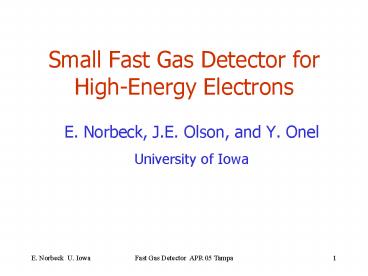Small Fast Gas Detector for HighEnergy Electrons - PowerPoint PPT Presentation
1 / 19
Title:
Small Fast Gas Detector for HighEnergy Electrons
Description:
Fast Gas Detector APR 05 Tampa. 1. Small Fast Gas Detector for High-Energy Electrons ... Fast Gas Detector APR 05 Tampa. 3. For high speed, the RC time ... – PowerPoint PPT presentation
Number of Views:34
Avg rating:3.0/5.0
Title: Small Fast Gas Detector for HighEnergy Electrons
1
Small Fast Gas Detector for High-Energy Electrons
- E. Norbeck, J.E. Olson, and Y. Onel
- University of Iowa
2
Example of low-pressure PPAC (Parallel Plate
Avalanche Counter)
- Two flat plates
- Separated by 1 mm
- Filled with 100 torr hydrocarbon
- 1000 V between plates
- Simple, low cost device
- Unaffected by heat, light
- Can be radiation hard
3
Speed vs Size
For high speed, the RC time constant must be kept
small. Only PPACs of small area are fast, 1 ns R
50 O (coax cable). C is the capacity between
the plates
4
Single Pixel PPAC
- Gap 0.6 mm 950 V across gap
- Cathode 7X0 29 mm of tantalum
- Area of anode is 1.0 cm2
- Guard ring to simulate neighboring pixels
Detail of gap and guard ring
5
New Detector with less inductance Same signal
width of 1.5 ns for isobutane at 80 torr.
6
Test at home with a 7 mCi 137Cs source
Get up to 20 mV signals directly into 50 W coax
7
Signal into coax with no amplifier
C(out)
Signal observed directly with fast scope
8
The signal is divided between the detector
capacitance and the output capacitance. The sum
of the two provides energy for damaging sparks.
For small detectors we use a ratio of 20. For
large detectors we make them equal.
9
We did not have high-energy electrons so we made
them in situ from protons interacting near the
front end of our tantalum cylinder.
The showers had amplitudes as much as 40 mV
10
Signal Shape from Shower
One third of amplitude of fast signal is lost in
20 m of standard RG-58 coax.
11
- The signal comes from moving charges.
- In an avalanche, most of the electrons and ions
are formed near the anode. - The electron signal is fast but with a total area
small compared with the ion signal. - The ion signal is flat while the ions are moving
and stops when the ions are collected. - In the next slide, when the ions are collected at
the cathode they liberate electrons.
12
20 torr ethane 550 V 0.6 mm gap
13
Gases that have been used
- C4H10
- C2H6
- CH4
Alkanes work well as avalanche gases
- CF4
- C3F8
- C4F8 cyclo
Additional benefit with perfluoro-analog
- Argon -CO2
But only at 1 atm pressure
14
Many advantages to operating at atmospheric
pressure
CF4 gives nice signals at 2500 V 95 Ar 5
CO2 operates at 1100 V, but with a slow, 5 ns,
fast signal. It also has a smaller useful
operating range than CF4
For 0.6 mm spacing
15
Advantages of Perfluro gasses
Not toxic Does not burn Resists aging Easily
recycled (A small chemical cartridge can be
inserted in the gas line that will remove all
impurities from the gas) High density (more
primary electrons) Contains no chlorine so is
allowed in national laboratories
We found good results with 0.6 mm spacing, but
not so good with 2.5 mm. More study on this is
needed.
16
One plate can be divided into pixels to provide
position resolution.
17
PPAC Readout
Summing amplifier can be used to add PPAC
signals, increasing the effective size of PPAC
(without increasing the time width of the
signals)
18
Cautions
Simple scaling of plate spacing, pressure,
voltage, etc. does not apply over a wide range of
parameters. Look at wave form to make sure the
signal is clean.
19
CONCLUSIONS
- Can connect PPACs directly into 50 W coax
- Can test with g source on side
PPACs for a calorimeter
- Can be made radiation hard.
- Can provide position information.
- Have good energy resolution for high energy
showers. - Have sub nanosecond time resolution.

